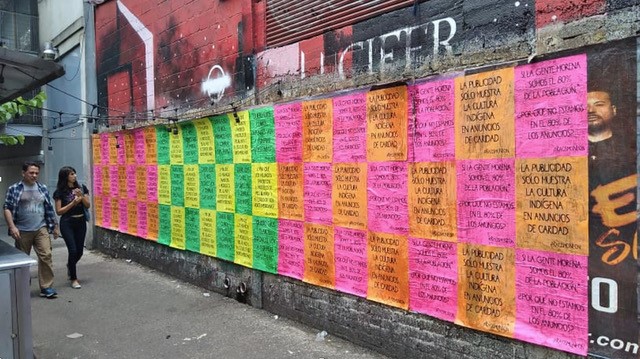CARL W. JONES
I argue that Advertising in Mexico is a means employed by the ruling class in order to colonize Mexican society. It re-enforces a colonial thinking that started to be imposed five centuries ago by invaders of what is currently called the nation state of Mexico. My argument is based on a theoretical framework that maps the history of key concepts such as Post-colonisation and Decolonization. Anzaldua and Drussel’s definition of colonization from a Latin American point of view, and Mignolo’s observations on decolonization through ‘delinking knowledge’ are applied to advertising to reveal how this field can possibly be decolonized. The basis of the practice part of my PhD by Practice that is discussed in this article are theories of Detournement and Guerrilla semiotics. An important part of the strategy for this practice is using social media to search for solutions that can be reflected back at Mexican citizens in order to inspire a social transformation within the advertising industry.

Carl W. Jones
Carl W. Jones is Senior Lecturer at the Westminster School of Media and Communication, research member of the Communication and Media Research Institute and a PhD candidate at the Royal College of Art in London. With a rich experience in marketing and advertising, he is now undertaking academic teaching and research on discrimination in advertising.
Please take a look at these four Mexican advertisements, and think about what is not there:

In a country like Mexico where 90% of the citizens are people of colour (POC) I ask why are indigenous or POC not appearing in these advertisements, or in the hundreds created every day in the metropolis of Mexico City? What is not shown is important, as it is a form of erasure, a way to forget certain peoples.
When I first moved to Mexico to work in the advertising industry in the 1990’s, my title was Creative Art Director and I couldn’t help but wonder why the people I saw on the street were not shown in the advertising, which featured what would be considered to a Mexican audience as mostly models with European features such as lighter skin. As part of my job, I had to recommend actors and models to appear in the advertisements and I would pick people of colour who reflected what I saw on the streets of Mexico. However, my clients would usually select models that appeared like a stereotypical European with lighter hair and eyes, even though those same clients were often what is termed in Mexico as ‘Moreno’ or mixed race that tend to have a darker skin tone and dark eyes.
After 20 years working in the practice of advertising I switched to academia and decided to investigate racism and decolonial theory for my PhD by practice. My research revealed that many advertisements contain two meanings (Jones 2015). One that the brand wants consumers to see and the secondary messages that re-enforce colonial concepts such as race, class and gender (Jones 2018). Therefore, I propose that advertising is a tool used by the ruling class in order to colonize.
For over 100 years western advertising agencies have been invading developing countries and promoting their clients’ brands through the appropriation of cultural codes and signs, that are re-interpreted, in order to seek authenticity with both the consumers and what Marx called ‘the ruling class.’ The spectacle of Advertising is part of mass media and encourages consumerism. French theorist Guy Debord in his book Society of the Spectacle (Debord 1995) defines The spectacle as everything “that once was directly lived has become mere representation” (thesis 1) and this representation can be defined as the ‘mass media’ (thesis 24).
In 1957, Debord founded the Situationists International (SI) which was made up of “avant-guard groups” (Knabb. ix) through an alliance with the mostly Paris based organization called Lettrist International (LI) merging with other vanguard organizations from Germany, England, and Scandinavia. (Debord 1992, p. 6). The S.I. produced the journal Internationale Situationniste and its first 200 copies were made available in 1958 with Debord as editor. The journal criticised popular culture through words and images.
The Situationists International (S.I.) dissolved in 1972 but their work inspired various writers, artists, and movements, including punk rock whose leader was Malcom Maclaren and this work often critiqued the ruling classes, or ‘peoples in power’ through the method of detournement. The advertising industry has also been directly challenged by the Canadian magazine Adbusters, through subvertisments, that make fun of commodity culture and capitalism. Subvertising can be described as “the production and dissemination of anti-ads that deflect Madison Avenue’s attempts to turn the consumer’s attention in a given direction, is a ubiquitous form of jamming. Often, it takes the form of “sniping” — illegal, late-night sneak attacks on public space by operatives armed with posters, brushes, and buckets of wheatpaste.” (Derry 1993). The world famous academic, book author and semiotician Umberto Echo claimed that in order to disrupt the mainstream, and keep control of the communication we need as a strategic solution, “to employ a guerrilla solution.” (Eco 1983, p. 11).
These are the main theories and methods that I employ to decode signs, including symbols which are then appropriated to ‘jam’ messaging through a weaponized advertising campaign. The rationale of this semiotic framework is to investigate if and how can advertising can be decolonized.
To accomplish this, I created seven different posters and placed them in sites close to where advertising agencies and their clients are located (Fig 5) in Mexico City. The name of the campaign is Racismo Neon (Neon racism) and the text printed on the posters is based on the literature review investigation. In total 4,000 posters were printed.

The Spanish language headlines translated into English are:
- If advertising reflects society, then advertising is racist.
- Whites are 10% of the population but are in 70% of the ads
- If Morenos are 80% of the population, why are we not in 80% of the ads?
- Advertising only reflects indigenous culture in charity ads
- “Consumers dream of being white even though they are brown”
- Why do ads favour white models and the American lifestyle?
- “I want blue eyes so I will buy these potato crips”
An important part of my research practice involves broadcasting on social media. I use social media to create a social transformation within the advertising community through an online conversation on how to decolonise Mexican advertising. Therefore, I created Racismo Neon social media pages on Twitter, Facebook and Instagram. To inspire online discussion, I took photographs of the posters in-situ, to post as content on social media along with the hashtag #racismoneon. If the targeted consumer did not walk past the posters on the street, then they could still see them in the social media posts.
After creating the social media conversation, I am now analysing it through Social Listening and content analysis of the conversation on social media and in the press. My objectives are to see if the Mexican advertising community agrees whether there is an issue with racism in advertising and search for solutions. Already a consensus seems to be crystalizing that there is such a problem. In this case, analysis of the online conversation will produce solutions.
Social media is a tool that can be used to both instigate racism and assist in decolonizing advertising. Through weaponizing advertising and going out to the very people who create messages, my research through practice has generated a conversation on social media, with the objective of inspiring a social transformation within the community. I believe that social media can be applied both as a negative, and positive tool. As a Negative tool it can be used as a method of control to spread disinformation. However, as a positive tool it can also be appropriated to generate a wide discussion with specific publics, and search for community-based solutions. My research through practice is not solving the process of decolonization, but is making a small contribution through the theoretical technique of subversive strategies.
References
Debord, G. (1992). Society of the spectacle and other films. London: Rebel press.
Debord, G. (1995). The society of the spectacle. New York: Zone books.
Dery, M. (2010 [1993]). Culture Jamming: Hacking, Slashing, and Sniping in the Empire of Signs. (last accessed November 25th 2022). This essay originally appeared in 1993, as Pamphlet #25 in the Open Magazine Pamphlet Series.
Eco, U. (1986). “Towards a Semiological Guerrilla Warfare.” In Travels in Hyperreality. New York: Harcourt Brace Jovanovich, pp. 138, 143, 144.
Jones, C. W. (2015). Ads send out more than the clients’ message. (last accessed April 2, 2021).
Jones, C. W. (2016). “Advertising tools and techniques appropriated to construct the global brand Mr. Clean”. In Proceedings of the world congress of the IASS/AIS 12th WCS Sofia 2014 New Semiotics. Sofia: NBU press. DOI: 10.24308/iass-2014-062.
Jones, C. W. (2018). Racism and Classism in Mexican Advertising.In Olteanu, A., Stables, A., Borţun, D. (eds) Meanings & Co. Numanities – Arts and Humanities in Progress, vol 6. Cham: Springer. https://doi.org/10.1007/978-3-319-91986-7_13.
Jones, Carl (2019) Personal Branding using advertising tools and techniques a case study. In Zantides, E. (ed.) Semiotics and Visual Communication III: Cultures of Branding, Newcastle upon Tyne: Cambridge Scholars.
Knabb, Kenn (2006) Situationist international anthology. revised and expanded edition. Berkley, Ca.: Bureau of public secrets.
Figures
Fig 1-4: “MI BELLEZA NO TIENE NADA QUE ESCONDER” / “MI JUVENTUD SE GANA CON LOS AÑOS” / “MI GÉNERO NO TIENE GÉNERO” / “SOY LA MEDIDA PERFECTA” Billboards. Espectacular. 2018. Client: Palacio de Hierro. Mexico City. Palacio Billboard broadcast in Mexico City, and other cities where Palacio De Hierro has stores. First air date TBC 6.3.2018. Images obtained from news article. Source. 03/03/2018. Excelsior. https://www.excelsior.com.mx/de-la-red/2018/03/03/1223987 (last accessed 23 Nov. 2022), see also: https://www.sdpnoticias.com/estilo-de-vida/2018/03/06/el-palacio-de-hierro-lanza-campana-que-busca-romper-con-estereotipos (last accessed April 2nd 2021).
Fig 5: Racismo Neon posters in the streets of Mexico City. Photo Carl Jones (authors own) July 2022.
Proposed citation: Jones, Carl W. (2022). Decolonising Advertising through content creation, broadcast on social media, to inspire social transformation. https://khk.rwth-aachen.de/2022/12/02/5074/5074


